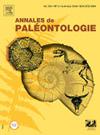Symbiosis in late Silurian (Ludfordian) bryozoans from Saaremaa Island, Estonia
IF 0.7
4区 地球科学
Q4 PALEONTOLOGY
引用次数: 0
Abstract
Six new symbiotic associations between erect branching bryozoan colonies and tentaculitoid tubeworm-like organisms have been described from argillaceous carbonate rocks of the Ludfordian of Saaremaa Island, Estonia. Several symbiotic associations occur in the Kuressaare Formation: Conchicolites sp.– Fistulipora sp. A and Fistulipora sp. B, Palaeoconchus sp. – Fistulipora sp. A, Conchicolites sp. – ?Eridotrypella sp., Conchicolites sp.– ?Anisotrypa proavus, Conchicolites sp. –?Leptotrypella versimilis and Monotrypa sp. – unknown endozoobiont association. The colonization of bryozoans by cornulitids and microconchids likely occurred because the former provided a suitable hard substrate on an otherwise soft clay sea floor. Most cornulitids had endobiotic life modes and were completely intergrown with their host bryozoans. There is no evidence of how cornulitids might have provided some advantage to the bryozoan host. However, given the likelihood of feeding competition, these associations are more appropriately qualified as mildly parasitic.
爱沙尼亚萨雷马岛晚志留世(卢德福)苔藓虫的共生关系
在爱沙尼亚萨雷马岛卢德福尔德的泥质碳酸盐岩中,描述了直立分支苔藓虫群落和触手状管虫样生物之间的六个新的共生关系。在Kuressaare组中出现了几种共生组合:孔雀石sp. - Fistulipora sp. A和Fistulipora sp. B,古孔雀石sp. - Fistulipora sp. A,孔雀石sp. - ?锥虫类,孔雀石类?孔雀石属- ?蛭状细锥虫和单锥虫-未知的内源性生物关联。珊瑚虫和微贝壳虫的定植可能是因为前者在柔软的粘土海底提供了合适的坚硬基质。大多数柱体具有内源性生活方式,并与寄主苔藓虫完全共生。没有证据表明锥体如何为苔藓虫宿主提供一些优势。然而,考虑到喂养竞争的可能性,这些关联更合适地称为轻度寄生。
本文章由计算机程序翻译,如有差异,请以英文原文为准。
求助全文
约1分钟内获得全文
求助全文
来源期刊

Annales de Paleontologie
地学-古生物学
CiteScore
1.70
自引率
10.00%
发文量
8
审稿时长
>12 weeks
期刊介绍:
Créées par Marcellin Boule en 1905, les Annales de Paléontologie publient 4 numéros par an traitant des fossiles animaux et végétaux, dans tous les domaines de la paléontologie incluant :
-La Paléoanatomie-
La Paléohistologie-
La Morphologie fonctionnelle-
La Systématique-
L''Évolution-
La Paléoécologie
... et toute les contributions susceptibles d''améliorer la compréhension des organismes et des environnements éteints.
 求助内容:
求助内容: 应助结果提醒方式:
应助结果提醒方式:


